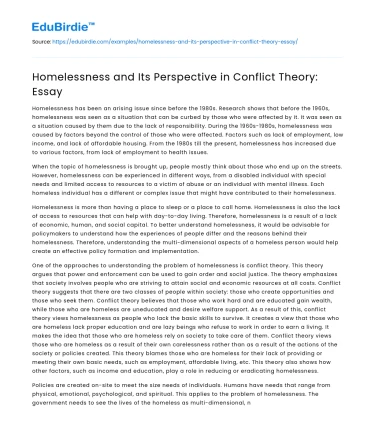Homelessness has been an arising issue since before the 1980s. Research shows that before the 1960s, homelessness was seen as a situation that can be curbed by those who were affected by it. It was seen as a situation caused by them due to the lack of responsibility. During the 1960s-1980s, homelessness was caused by factors beyond the control of those who were affected. Factors such as lack of employment, low income, and lack of affordable housing. From the 1980s till the present, homelessness has increased due to various factors, from lack of employment to health issues.
When the topic of homelessness is brought up, people mostly think about those who end up on the streets. However, homelessness can be experienced in different ways, from a disabled individual with special needs and limited access to resources to a victim of abuse or an individual with mental illness. Each homeless individual has a different or complex issue that might have contributed to their homelessness.
Save your time!
We can take care of your essay
- Proper editing and formatting
- Free revision, title page, and bibliography
- Flexible prices and money-back guarantee
Homelessness is more than having a place to sleep or a place to call home. Homelessness is also the lack of access to resources that can help with day-to-day living. Therefore, homelessness is a result of a lack of economic, human, and social capital. To better understand homelessness, it would be advisable for policymakers to understand how the experiences of people differ and the reasons behind their homelessness. Therefore, understanding the multi-dimensional aspects of a homeless person would help create an effective policy formation and implementation.
One of the approaches to understanding the problem of homelessness is conflict theory. This theory argues that power and enforcement can be used to gain order and social justice. The theory emphasizes that society involves people who are striving to attain social and economic resources at all costs. Conflict theory suggests that there are two classes of people within society: those who create opportunities and those who seek them. Conflict theory believes that those who work hard and are educated gain wealth, while those who are homeless are uneducated and desire welfare support. As a result of this, conflict theory views homelessness as people who lack the basic skills to survive. It creates a view that those who are homeless lack proper education and are lazy beings who refuse to work in order to earn a living. It makes the idea that those who are homeless rely on society to take care of them. Conflict theory views those who are homeless as a result of their own carelessness rather than as a result of the actions of the society or policies created. This theory blames those who are homeless for their lack of providing or meeting their own basic needs, such as employment, affordable living, etc. This theory also shows how other factors, such as income and education, play a role in reducing or eradicating homelessness.
Policies are created on-site to meet the size needs of individuals. Humans have needs that range from physical, emotional, psychological, and spiritual. This applies to the problem of homelessness. The government needs to see the lives of the homeless as multi-dimensional, not one-dimensional, by considering different approaches, in order to really help them.






 Stuck on your essay?
Stuck on your essay?

